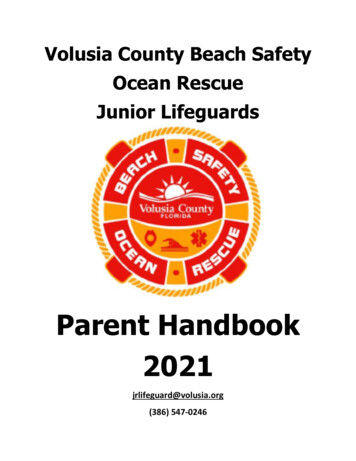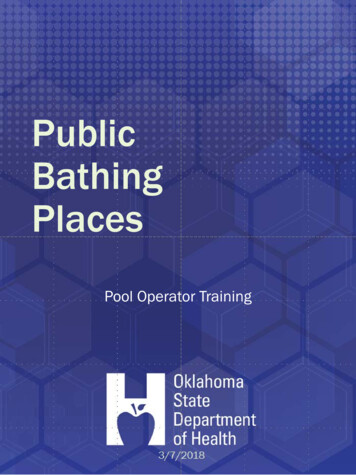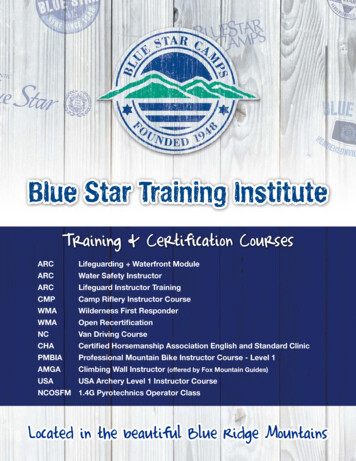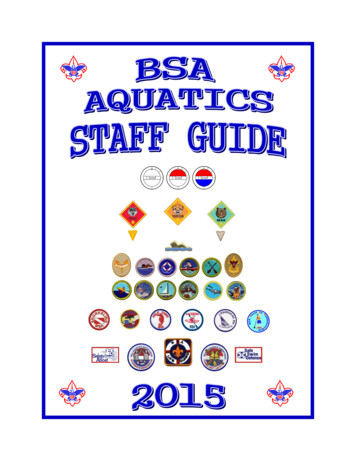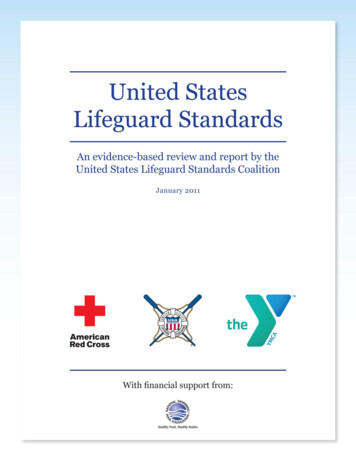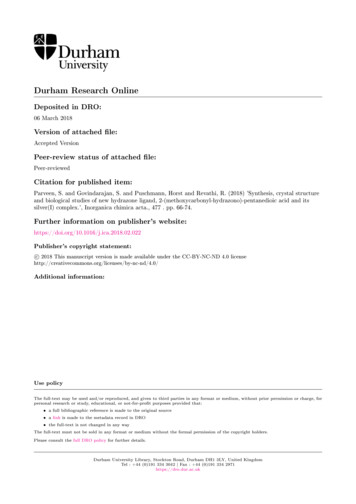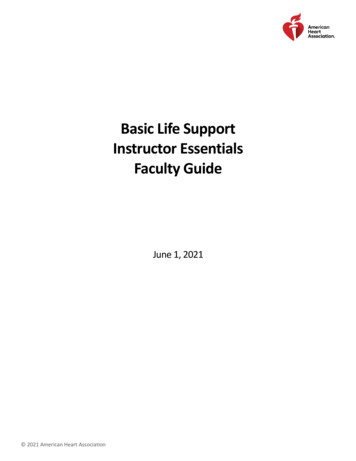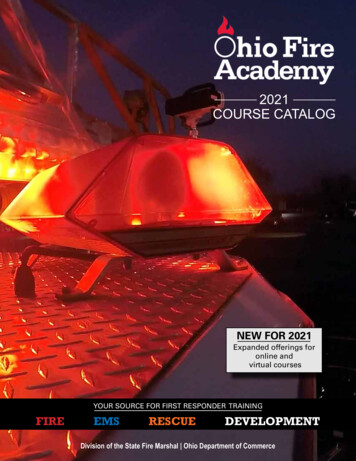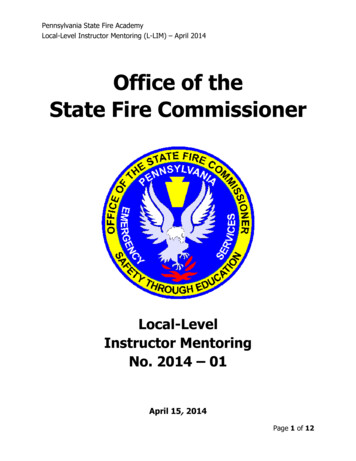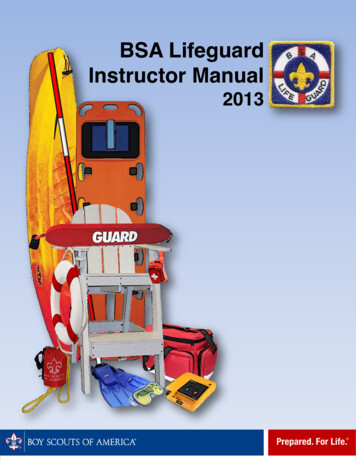
Transcription
BSA LifeguardInstructor Manual2013
ISBN 978-0-8395-4519-42013 Printing
ContentsIntroduction .5BSA Lifeguard Requirements . 7Completion Options . 9Unit 1: Prerequisites and Course Overview .10Unit 2: The BSA Lifeguard as a Professional .12Unit 3: Safety Standards and Risk Management .16Unit 4: Surveillance and Victim Recognition .20Unit 5: Introduction to Rescue Equipment, Entries, and Approaches .24Unit 6: Entries and Rescue Approaches .25Unit 7: Introduction to Assists and Rescues .27Unit 8: Reaching and Throwing Assists .28Unit 9: Moving the Victim to Safety and Rescues .31Unit 10: Introduction to Multiple and Submerged Victim Rescues and Escapes .34Unit 11: Multiple and Submerged Victim Rescues and Escapes .36Unit 12: Introduction to Victim Removal .38Unit 13: Removal From the Water .39Unit 14: Introduction to Rescue Watercraft .40Unit 15: Rescue Watercraft.43Unit 16: Safe Swim Defense .45Unit 17: Emergency Action Plans .48Unit 18: Introduction to Lost Swimmer Search and Use of Mask and Fins .51Unit 19: Lost Swimmer Search and Use of Mask and Fins.53Unit 20: Spinal Injuries and Caring for Spinal Injuries on Land .54Unit 21: Spinal Injury Management—Introduction to In-line Stabilization in the Water .56Unit 22: Spinal Injury Management—In-line Stabilization in the Water .59Unit 23: Spinal Injury Management—Introduction to Backboarding .62Unit 24: Spinal Injury Management—Backboarding .63Unit 25: Written Test .65Unit 26: Final In-Water Skills Demonstration .66Unit 27: Supervised Lifeguarding I .68Unit 28: Supervised Lifeguarding II .71
Appendix .73Aquatics Emergency Action Plan Example . 73Knowledge Test Version A. 79Knowledge Test Version B . 86Knowledge Test Answer Sheet . 93Knowledge Test A Answer Key . 94Knowledge Test B Answer Key . 95Application for BSA Lifeguard . 96Application for BSA Lifeguard Instructor . 98Suggested Schedule for a Resident Scout Camp . 99Suggested Schedule for an Evening Course . 102Suggested Schedule for a Two Weekend Course . 105Suggested Schedule for Renewal Training . 109Suggested Schedule for Crossover Training . 113Buddy Board Examples . 118Lifeguard Rescue Reporting System . 120
IntroductionThe primary purpose of the BSA Lifeguard training program is toprovide professional lifeguards for BSA operated facilities, councilaquatics committees, and year-round aquatics programming. In addition,this training is intended to meet the requirements of government agenciesfor operations at a regulated swimming venue. The program is open to allregistered adults and youth, age 15 and older. BSA Lifeguard isrecommended for aquatics staff lifeguard training and for those whowish to work as lifeguards for BSA year-round aquatics programs. Forthose supporting council aquatics committees, this training is the next step beyond the AquaticsSupervision program for unit leaders. This manual, along with the BSA Lifeguard Application,test questions, BSA referenced materials, and American Red Cross Lifeguarding manual, are thesupporting materials necessary for the instruction of BSA Lifeguard.For three-quarters of a century, BSA Lifeguard and its predecessor, Scout Lifeguard, served theneeds of both units and summer camps for water safety leadership training. Over that time, moreand more programs requiring specialized skills were added, and at one point, BSA Lifeguardrequirements included the skills for the Swimming, Lifesaving, Canoeing, Rowing, and First Aidmerit badges. The skills that define the standard of care for professional lifeguarding, such asspinal injury management, have also evolved significantly. These changes have made itincreasingly difficult to meet all the needs of the unit leader and the lifeguard for summer campand year-round aquatics programs in a single training course of reasonable duration. As a result,the emphasis of BSA Lifeguard changed in 2009 from a training program designed to support theunit to one designed to support districts and councils.Those familiar with American Red Cross (ARC) lifeguard training will notice the basic skillsrequired for BSA Lifeguard are similar to those of the ARC Lifeguarding program. Thatassociation is deliberate. ARC training for professional lifeguards in non-surf situations is widelyrecognized, and ARC professionals work closely with BSA professionals and volunteers. TheBSA, however, has extensive experience conducting youth swimming activities both inside andoutside of camp and has program-specific needs that must be addressed. BSA Lifeguard trainingincludes basic prevention strategies, such as universally applied swimmer classification tests andother operating procedures that are not included in sufficient detail in ARC training. As a result,to best support teaching the skills and knowledge required for BSA Lifeguard, the American RedCross Lifeguarding Manual is a required resource for BSA Lifeguard instructors and candidates.In addition, instructors are required to use the American Red Cross Lifeguarding video segments.These video segments are available on DVD or, for qualified ARC Lifeguarding Instructors, online using the American Red Cross Instructor’s Corner website. Finally, the American Red CrossLifeguarding Instructors Manual is recommended. Local councils are strongly encouraged tobuy at least one copy of these resources for use by their BSA Lifeguard Instructors.Your key responsibility as a BSA Lifeguard Instructor is to make certain the candidate meets thestandards of BSA Lifeguard, both in skills and attitude. This manual has been prepared to helpyou provide the training necessary to qualify those seeking training as a BSA Lifeguard.BSA Lifeguard Instructor Manual — 5
Course OrganizationWhen conducting a BSA Lifeguard training program, classes should be organized with a ratio of6 to 10 candidates per instructor. The training course is divided into 28 instructional units. Eachunit has a prerequisite and an estimated or allotted time for completion. The allotted time foreach unit varies, and flexibility in scheduling is allowed to accommodate different situations solong as the material from each unit is covered. The appendix includes suggested courseschedules for teaching at different venues. The total time allotted for the course includingprerequisite testing and course overview is 25! hours. This time may vary depending upon thenumber of candidates and their backgrounds.Each unit specifies the unit objective, applicable requirements, learning objectives, and materialsand equipment needed. The unit objective supports the BSA Lifeguard requirements andspecifies the level of competency desired of the student. Knowledge Level (Know)—The student is expected to recall from memory or correctlyidentify information. Comprehension Level (Comprehend)—The student is expected to understand proceduresor grasp the meaning of information. This is the first level of understanding by the student. Application Level (Apply)—The student is expected to use information and skills to achievean acceptable outcome in new or different situations.Just as the unit objectives support the BSA Lifeguard requirements, the learning objectives arethe means to achieving the unit objective. They are the observable and measurable behaviors theinstructor should teach the student. Likewise, the student may use the objectives as a list of whathe or she is expected to learn.ReferencesBSA Reference MaterialsThe official source for Scouting merchandise is www.scoutstuff.org. These materials, publishedby the Boy Scouts of America and referred to in this course, are also available through your localcouncil service center or online at www.scouting.org. BSA Lifeguard application, No. 430-033Aquatics Supervision, No. 34346BSA Aquatics Staff GuideAmerican Red Cross Reference MaterialsMaterials published by the American Red Cross and referenced in this course are availabledirectly from Krames StayWell at www.shopstaywell.com or by phone at 800-667-2968. Lifeguarding Manual, No. 655735 (available in printed or electronic format, required)Lifeguarding video segments (DVD or ARC instructors may download online, required)Lifeguarding Instructor’s Manual (recommended), No. 655736BSA Lifeguard Instructor Manual — 6
BSA Lifeguard RequirementsTo be trained as a BSA Lifeguard, you must successfully complete the course as outlined in theBSA Lifeguard Instructor Manual and demonstrate the ability to perform each item specified inthe following requirements:PrerequisitesBefore doing requirements 6 through 26, complete the following:1. Submit proof of age. You must be at least 15 years old to participate.2. Submit written evidence of fitness for swimming activities (signed health history).3. Swim continuously for 550 yards, including at least 100 yards each of the following strokesin good form: front crawl, breaststroke, elementary backstroke, and sidestroke.4. Immediately following the above swim, tread water for two minutes with the legs only andthe hands under the armpits.5. Starting in the water, swim 20 yards using a front crawl or breaststroke, surface dive 7 to 10feet, retrieve a 10-pound object, surface, swim with the object 20 yards back to the startingpoint with both hands holding the object, and exit the water, all within 1 minute, 40 seconds.RequirementsComplete the following requirements within a 120-day period:6. Show evidence of current training in American Red Cross First Aid and American RedCross CPR/AED for the Professional Rescuer or equivalent (includes any training for acamp health officer recognized by BSA national camp standards).7. Demonstrate reaching assists from the deck using an arm, a rescue tube, and a pole.8. Demonstrate throwing assists using a throw bag and a ring buoy with a line attached. Throweach device such that the line lands within reach of a conscious subject 30 feet from shore.9. Demonstrate:a) Rescue of a conscious subject in deep water using a rescue board, kayak, rowboat, canoe,or other rescue craft that would be available at your local facility.b) Repeat for an unconscious subject.10. Demonstrate an entry and front approach with a rescue tube to a conscious subject in deepwater 30 feet away from shore. Position the rescue tube to support the subject and then assistthe subject to safety, providing direction and reassurance throughout.11. Demonstrate an entry and rear approach with a rescue tube to a conscious subject in deepwater 30 feet away from shore. Secure and support the subject from behind and then movethe subject to safety, providing direction and reassurance throughout.12. Demonstrate use of a rescue tube to assist two subjects grasping each other. Secure, supportand reassure both subjects. With the assistance of a second guard, calm and separate thesubjects and move them to safety.13. Demonstrate both front and rear head-hold escapes from a subject’s grasp.14. Demonstrate a feet-first entry in deep water with a rescue tube and swim an approach stroke25 yards within 25 seconds while trailing the tube.BSA Lifeguard Instructor Manual — 7
15. Demonstrate an entry and front approach with a rescue tube to a face-down passive subject30 feet away at or near the surface in deep water. Use a wrist roll to position the subjectface-up on the rescue tube, tow to safety, and remove them from the water with assistancewithin two minutes. Immediately perform a primary assessment and demonstrate one-personCPR for 3 minutes.16. Demonstrate an entry and rear approach with a rescue tube to a face-down unconscioussubject 30 feet away at or near the surface in deep water. Position the subject face-up, tow tosafety and remove them from the water with assistance within two minutes. Immediatelyperform a primary assessment and demonstrate two-person CPR for 3-minutes.17. Demonstrate in-water ventilation of an unconscious subject when prompt removal from thewater is not possible. Open the airway, position the mask, and simulate ventilations.18. Demonstrate an entry and approach with a rescue tube for use when an unconscious subjectis submerged face-down at or near the bottom in 6 to 8 feet of water. Bring the subject to thesurface and tow to the nearest point of safety.19. Remove a subject from the water using each of the following techniques in the appropriatecircumstances with the aid of a second rescuer:a) Vertical lift at the edge of a pool or pier using a backboardb) Walking assistc) Beach drag20. Participate in multiple-rescuer search techniques appropriate for a missing subject inmurky water:a) Line search in shallow waterb) Underwater line search in deep water without equipmentc) Underwater line search in deep water with mask and fins21. Demonstrate in-line stabilization for a face-down subject with suspected spinal injury in veryshallow water (18 inches or less).22. Demonstrate in-line stabilization for a suspected spinal injury in shallow water (waist tochest deep):a) For a face-up subjectb) For a face-down subject23. Demonstrate in-line stabilization for a suspected spinal injury in deep water, swim thesubject to shallow water, confirm vital signs, and with the assistance of three others, removethe subject from the water using a backboard with straps and a head immobilization device.24. Demonstrate care for a spinal injury on land in the following situations:a) Non-standing subjectb) Standing subject including securing to a backboard and lowering to the ground.25. Correctly answer 80 percent of the questions on the BSA Lifeguard knowledge test coveringthe course material. Review any incomplete or incorrect answers.26. Serve as a lifeguard, under supervision, for at least two separate BSA swimming activitiesfor a combined time of two hours. Afterward, discuss the experience with the lifeguardinginstructor.BSA Lifeguard Instructor Manual — 8
Completion OptionsCourse completion cards are valid only when signed by either a current BSA Aquatics Instructoror BSA Lifeguard Instructor approved by the local council. Training is valid for two years,provided First Aid and CPR/AED for the Professional Rescuer training are kept current duringthat period.There are five ways to obtain a course completion card:1. Course Completion—Complete all requirements in the instructor manual during ascheduled course of instruction. The participant must attend all course sessions. Makeupsessions are allowed at the instructor’s discretion. If an individual is unable to completeall requirements during the scheduled course, the instructor may elect to continue traininguntil the participant is able to complete all the requirements provided the total elapsedtime from start to finish does not exceed the 120-day period.2. Renewal Challenge—Anyone with a BSA Lifeguard completion card that is current orhas expired within six months may renew or extend the training by performingrequirements 2 through 25 without attending the standard course sessions. Prior to thetesting, the instructor may provide a renewal training session to review and update skillsand information. Summer camp aquatics directors should renew training for aquatics staffmembers during pre-camp training while emphasizing local camp facilities, procedures,and emergency action plans.3. Crossover Challenge—Anyone who holds current training in American Red CrossLifeguarding, American Red Cross Waterfront Lifeguarding, or other lifeguard trainingprograms may obtain a BSA Lifeguard completion card by performing requirements 1through 26 without attending the standard course sessions. The lifeguard trainingprogram that issued the training certificate must be recognized by the local or stateregulatory agency that sets standards for lifeguards at youth camps. The instructor mayprovide a crossover training session to review and update skills and information prior tothe testing. The applicant may receive credit for requirement 26 if within the past 18months he or she has served as a lifeguard, under supervision, or has supervisedlifeguards, for at least two separate BSA swimming activities for a combined time of twohours. Otherwise, due to BSA procedures not implemented at other lifeguarding venues,the applicant must accomplish requirement 26.4. Completion of BSA Aquatics Instructor – Anyone who completes BSA AquaticsInstructor training at National Camping School.5. Co-instructors (BSA Aquatics Instructor or BSA Lifeguard Instructor) may each sign acompletion card for the other at the conclusion of a BSA Lifeguard course if they satisfyrequirements 2 through 24.Note: These new requirements are effective May 3, 2013. The previous requirements may beused through August 31, 2013. After that date, all applications for BSA Lifeguard must besubmitted using the new requirements. BSA Lifeguard certificates issued after May 3, 2013,regardless of the requirements used, are valid for two years. Instructors are authorized tomake pen and ink changes to the existing stock of cards until new cards are available.BSA Lifeguard Instructor Manual — 9
Unit 1: Prerequisites and Course OverviewAllotted Time2 hoursMaterials and Equipment! 10-pound diving brick! Stopwatch or timer! Candidate rosterOne per candidate of each of the following:! BSA Lifeguard application, No. 430-033, or list of requirements! Aquatics Supervision, No. 34346! BSA Aquatics Staff Guide! American Red Cross Lifeguarding Manual, No. 655735! Schedule (locally produced)Course Prerequisites1. Verify proof of age. You must be at least 15 years old to participate. The candidatemust be 15 years old on the date the course begins. Request reasonable proof of age such as abirth certificate, passport, photo identification card, or other form of identification at thediscretion of the instructor.2. Submit written evidence of fitness for swimming activities (signed health history).Review the health history and discuss any physical limitations.3. Swim continuously for 550 yards, including at least 100 yards each of the followingstrokes in good form: front crawl, breaststroke, elementary backstroke, and sidestroke.The swimmer must be able to cover the distance with a strong, confident stroke. The 550yards must not be the outer limit of the swimmer’s ability, and completion of the distanceshould demonstrate sufficient stamina to complete the course.4. Immediately following the above swim, tread water for two minutes with the legsonly and the hands under the armpits. The candidate must maintain an upright position inwater over the head in depth. The hands must be placed under the armpits and the shouldersmay remain under the water with only the head above water.5. Starting in the water, swim 20 yards using a front crawl or breaststroke, surfacedive seven to 10 feet, retrieve a 10-pound object, surface, swim with the object 20 yardsback to the starting point with both hands holding the object, and exit the water, allwithin 1 minute, 40 seconds. This prerequisite tests the candidate’s ability to surface dive,swim underwater, locate an object, and swim while burdened within a relatively short periodof time. The candidate may swim on his or her back while keeping both hands on the object.In turbid water, the instructor may indicate the approximate location of the submerged object.The candidate may not use a mask, goggles, or fins while performing this prerequisite.Wrap-UpCongratulate those who successfully completed the prerequisites. Privately counsel andencourage those who were not able to complete the required skills.BSA Lifeguard Instructor Manual — 10
Course Overview Introductionso Instructors and staffo CandidatesReview the facilityo Restroom locationo Building exitso Drinking watero Severe weather shelter – Where to go in the event of a thunderstorm.Review the course objectives:o Prevent and respond to aquatics emergencies.o Prepare candidates for service as professional lifeguards.o Prepare lifeguards for service at Scouting venues and events, including:" Resident camps" District and council aquatics eventsCompletion standards:o Attend all sessions.o Satisfactorily perform the required skills.o Score a minimum of 80 percent on the knowledge test.o CPR/AED for the Professional Rescuer and First Aid" Verify certificates of those who have already completed the training." Make arrangements for candidates to complete requirement 6 early in the course." Discuss completion options for CPR/AED for the Professional Rescuer and First Aid.o If qualified, instructors may teach the courses concurrent with the lifeguard courseor may use a qualified guest instructor. Note: Instructors are encouraged to seekqualification as a CPR and first aid instructor through the BSA Licensed TrainingProvider (LTP) Agreement with the American Red Cross.o Direct candidates to courses taught by others.o Complete all requirements within 120 days.Distribute the following materials:o Aquatics Supervision, No. 34346o American Red Cross Lifeguarding Manual, No. 655735o Schedule (locally prepared)Encourage those who have not completed Safe Swim Defense and Safety Afloat trainingwithin the past two years to complete the online training using the E-Learning CourseManagement System at my.scouting.org.The instructor may also conduct training as needed.File health histories in a secure location.Wrap-UpAnswer questions and make study assignments for the next unit.BSA Lifeguard Instructor Manual — 11
Unit 2: The BSA Lifeguard as a ProfessionalAllotted Time1 hour, 30 minutesPrerequisite UnitUnit 1 – Prerequisites and Course OverviewUnit ObjectiveAt the completion of this unit, each participant should: Comprehend the expected standards of behavior and responsibilities of a BSA Lifeguard.Be able to apply decision-making strategies to solve problems.Know the legal considerations and responsibilities of a BSA Lifeguard.Know the type of supervision and support to expect from an aquatics director.Learning Objectives State the appropriate dress, demeanor, and punctuality of an aquatics staff member.Describe proper ways to interact with unit leaders.Identify common perceptions associated with various body languages.Contrast the supervision and instruction required for the different stages ofyouth development.Define legal considerations and identify how they affect a lifeguard.Identify examples of negligence by a lifeguard in a camp setting.Define negligence as the failure to follow policies, standards, or rules.Describe the supervision and support a lifeguard should expect to receive from theaquatics director.Materials and Equipment! Aquatics Supervision, No. 34346! BSA Aquatics Staff Guide! American Red Cross Lifeguarding manual, No. 655735! American Red Cross Lifeguarding DVD set, No. 655739, or online video segments! Marker board with pens! Flip charts, overhead projector, or video projector with screen! DVD player and television, or video projector and screenBSA Lifeguard Instructor Manual — 12
Characteristics and Responsibilities of a BSA LifeguardReference: Lifeguarding, pages 2–5! Show the Lifeguarding video segment “The Professional Lifeguard” (3:37). Additional characteristics expected of a lifeguard at a Boy Scout camp:o Because we are serving at a Boy Scout aquatics venue, there are additional expectations: The ideals of Scouting:o The Boy Scouts of America is a character-building organization.o Professionalism in lifeguarding supports the aims of Scouting.o BSA Lifeguards are expected to follow the Scout Oath and Law. Personal appearance:o Lifeguards should be well groomed.o Sit or stand upright at the lifeguard station.o Clothing: Swimwear should be comfortable, functional, and simple—boxer-style (notbriefs) for males and one-piece or modest two-piece (not bikini) for females. T-shirts should be Scouting-appropriate with no commercial advertising orpolitical statements. Camps may have their own standards regarding T-shirts and swimwear tomake guard personnel easy to recognize.o Hair should be maintained so it does not interfere with rescue procedures.o Jewelry, including any body piercing, should not expose the guard to potentialharm while performing duties, including rescues. Youth development:o Preadolescent, preteens—respect for authority, developing physical coordination, limitedattention spano Adolescents, teenagers—peer pressure, puberty, increasing cognitive development,challenge authorityo Discuss how age development may affect how you interact with individuals. Decision-making skills:o Preparing for common situations makes the decision easier.o Introduce the FIND model (Re: Lifeguarding Manual page 6)" F-figure out the problem" I-identify possible solutions" N-Name the pros and cons for each solution" D-decide which solution is best, then act on ito Divide the buddy teams into three groups:" Assign one scenario to each group." Have the group apply the FIND decision-making model to form a viable solution." Have a spokesperson for each group explain how they developedtheir solution.BSA Lifeguard Instructor Manual — 13
Scenario 1“Who’s Your Buddy?” Two buddies are often several yards away from each other andunaware of the other’s situation. You call a buddy check. They initially can’t locate eachother but finally “buddy up” just as you complete the count to 10.Scenario 2“Let’s Go Exploring!” Two buddies decide to do some exploring. You look downbetween the boards of the floating dock and realize they are under the dock in aconvenient space between the floats. You admonish them and they return to the swimarea at your direction. A few minutes later, another guard makes a similar discovery ofthe same buddy pair in the area of the floating dock beneath his feet. They laugh andreturn to the swim area at the guard’s direction.Scenario 3“Go Long!” A beginner is paired with a swimmer, and the buddy pair is checked in onthe buddy board in the beginner area. You notice the buddy pair is missing from thebeginner area. You find the beginner standing on the deck in the swimmer area throwinga ball to his buddy, the swimmer, who is in the water in the swimmer’s area. They’rehaving a great time. Legal considerations. Discuss each of the following and examples of how they affectlifeguards (Re: Lifeguarding Manual page 6-8):o Duty to act – While on duty you have a responsibility to act in an emergency.o Standard of care – may be established by government regulation or industry standards." Recognize hazards and communicate to prevent injury" Recognize when so
Cross Lifeguarding Manual is a required resource for BSA Lifeguard instructors and candidates. In addition, instructors are required to use the American Red Cross Lifeguarding video
